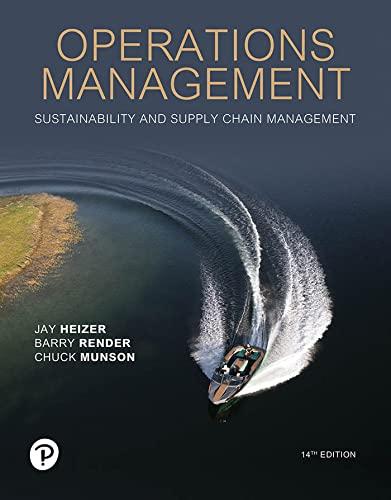Good airline scheduling is essential to delivering outstanding customer service with high plane utilization rates. Airlines must
Question:
Good airline scheduling is essential to delivering outstanding customer service with high plane utilization rates. Airlines must schedule pilots, flight attendants, aircraft, baggage handlers, customer service agents, and ramp crews. At Alaska Airlines, it all begins with seasonal flight schedules that are developed 330 days in advance. Revenue and marketing goals drive the potential routing decisions, but thousands of constraints impact these schedules. Using SABRE scheduling optimizer software, Alaska considers the number of planes available, seat capacity, ranges, crew availability, union contracts that dictate hours that crews can fly, and maintenance regulations that regularly take planes out of service, just to name a few. Alaska’s scheduling department sends preliminary schedules to the human resources, maintenance, operations, customer service, marketing, and other departments for feedback before finalizing flight schedules. Alaska Airlines’ historic mission is to serve its extremely loyal customer base in the remote and unreachable small towns in Alaska. Serving many airports in Alaska is especially complex because the airline requires its pilots to have special skills to deal with extremely adverse weather, tight mountain passes, and short runways. Some airports lack full-time TSA agents or strong ground support and may not even be open 24 hours per day. In some cases, runways are not plowed because the village plow is busy clearing the roads for school buses. Navigational technology developed by Alaska Airlines has significantly reduced weatherrelated cancelled flights as Alaska can now land where many other carriers cannot. After the SABRE optimizer schedules thousands of flights, scheduling activity turns to the next step: crew optimizing. The crew optimizer (Alaska uses Jeppersen software developed by Boeing and based on linear programming) attempts to eliminate unnecessary layovers and crew idle time while adhering to FAA and union restrictions. Alaska leads the industry in pilot “hard time” (i.e., the amount of time a pilot is being paid when passengers are actually being moved). After the crew requirements for every flight are determined, the 3,000 flight attendants and 1,500 pilots rank their preferred routings on a monthly basis. Personnel are assigned to each flight using seniority and feasibility. Interestingly, not every pilot or flight attendant always bids on the Hawaii routes (about 20% of all flights), the long-haul East Coast routes, or the Mexico flights. Some prefer the flying challenge of the “milk run” flights to Ketchikan, Sitka, Juneau, Fairbanks, Anchorage, and back to Seattle, which are in keeping with the culture and contact with local residents. As an airline that accentuates risk taking and empowers employees to think “out of the box,” Alaska recently decided to experiment with a schedule change on its Seattle-to-Chicago route. Given crew restrictions on flying hours per day, the flight had previously included a crew layover in Chicago. When a company analyst documented the feasibility of running the same crew on the two 4-hour legs of the round trip (which implied an extremely tight turnaround schedule in Chicago), his data indicated that on 98.7% of the round trip flights, the crew would not “time out.” His boss gave the go-ahead.
Discussion Questions
1. Why is scheduling for Alaska more complex than for other airlines?
2. What operational considerations may prohibit Alaska from adding flights and more cities to its network?
3. What were the risks of keeping the same crew on the Seattle— Chicago—Seattle route?
4. Estimate the direct costs to the airline should the crew “time out” and not be able to fly its Boeing 737 back to Seattle from Chicago on the same day. These direct variable costs should include moving and parking the plane overnight along with hotel and meal costs for the crew and passengers. Do you think this is more advantageous than keeping a spare crew in Chicago?
Step by Step Answer:

Operations Management Sustainability And Supply Chain Management
ISBN: 9780137476442
14th Edition
Authors: Jay Heizer, Barry Render, Chuck Munson





